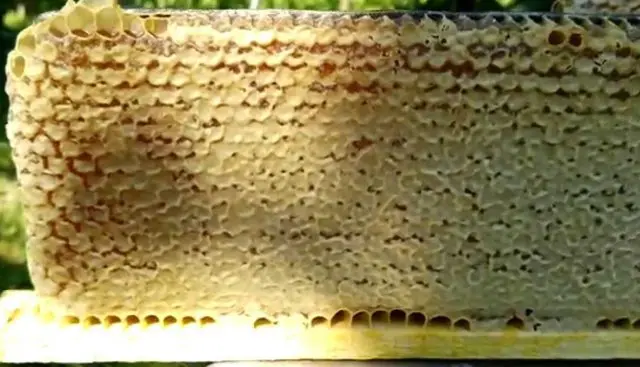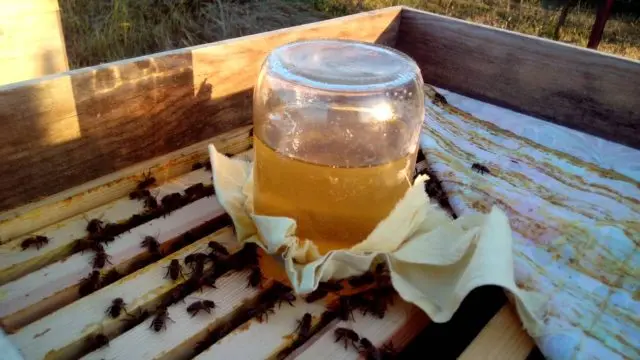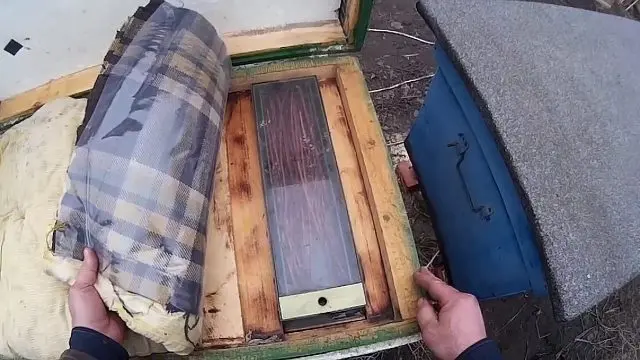Contents
The purpose of autumn feeding is to prepare the bees for a difficult and protracted winter period. Successful wintering of all members of the bee family is a guarantee of a rich harvest in the new year. It is important to make stocks of food for insects in time. Feeding bees in the fall is a whole science that every successful beekeeper must master.
The value of autumn feeding bees
After the last harvest in late August or early September, the bees begin to prepare for wintering. So that insects do not starve during the cold period, part of the honey is left in the combs.

Feeding insects in the fall, the beekeeper performs the following tasks:
- Providing them with nutrients before the onset of spring.
- Carrying out the prevention of diseases by adding drugs to the feed.
- Stimulation of uterine oviposition and growth of the bee colony.
Incentive feeding of bees in the fall during the season with adverse weather conditions allows the queen not to stop laying eggs. At the same time, old bees will not die from diseases, and young insects will receive a sufficient supply of protein and vitamins to start work in the spring.
As soon as the first pumping of honey has passed, the bees are fed so as not to stop the process of honey collection. The loss of the taken product is replenished, its deficiency does not affect the working capacity of insects.
The beekeeper must annually in the middle of summer create a supply of perga and pollen for wintering wards. On average, this is 2 frames of substance per 1 hive.
When to feed bees in the fall
For autumn feeding, beekeepers replace extra combs in the hive with feeders designed for 3 liters of syrup. Also for these purposes, glass drinkers in the form of jars, packing bags, perforated plastic bottles are used.
For a complete feeding, sugar syrup is prepared. Autumn food is more nutritious than spring food. The syrup is prepared in a ratio of 1:2 (water-sugar).
Honey sat is another type of autumn food. It is prepared from 1 kg of honey diluted in 1 liter of warm boiled water (50 ° C).
After the last honey collection, they begin to lay food in the hives. The timing of feeding bees in the fall may vary, depending on the region. Basically, the procedure begins in the second half of August, ends in the first half of September, the 10th is the deadline.
Later top dressings in the fall are considered unhealthy for insects. Young individuals will die during the processing of syrup before they live until spring. Only old insects are involved in this process, which will not survive until the first thaw anyway.
The first time to feed the bees in the fall begins after the final pumping out of honey. The process starts on August 20th. In the southern regions, the process may begin later: in early September, but no later than the 10th. In the second half of September, the event will not allow insects to process all the syrup until the offspring appear.
How much to feed the bees in autumn
To calculate, you need to know the approximate number of bee colonies in the apiary. Syrup or saty is prepared at the rate of 200 g per family per day. A syrup prepared in a ratio of 1: 1,5 (sugar-water) is considered to be of better quality and suitable for autumn feeding of insects.
For the first procedure in the fall, no more than 1 liter of fresh syrup is poured into the feeders. During the day, they observe how the bee colony processes it. As insects consume sweet food, the next portion is added. If families eat less sweet food, it is removed, and fresh food is added in a smaller amount. Syrup must not be allowed to sour.

To grow brood for winter, 0,5-1 l of honey per hive daily is enough. The birth of young individuals will be completed by mid-September. Until mid-October, after a cleansing flight, the bees will leave for the winter.
What to feed bees in autumn
Sugar top dressing is considered the most beneficial for the apiary. Honey food is considered more useful for insects, but costly for the economy.
Substances used as top dressing in autumn in apiaries:
- honey;
- sugar syrup;
- honey full;
- mixture of honey and sugar.
The type of food is determined by each beekeeper empirically. Any supplement has its own advantages and disadvantages.
How to feed bees with honey in autumn
For feeding, choose 2 frames with honey, print them out and put them in the first row in front of everyone else. You can install them on the edges.
If the honey in the comb has begun to crystallize, it is softened with a small amount of boiled water, dripping it into the free combs. As soon as it becomes liquid, it is sent to the hive.
Damage to the product occurs if it is stored in the hive for a long time at a temperature above + 10 ° C. Also, it can not be boiled and given to insects. It is poisonous to them.
In the absence of a product sealed in honeycombs in the apiary, collected (centrifugal) honey is used for autumn top dressing. Before giving it to the bees, it is diluted with water (1 cup of boiled water per 1 kg of the product). Everything is combined, poured into an enamel pan, heated in a water bath. As soon as the mass becomes homogeneous, it is poured into the feeders and sent to the hive. To save money, they use honey with sugar for autumn feeding of bees.
Feeding bees in the fall honey full
Honey, diluted with water in certain proportions, is full. It is prepared in autumn, so that after pitching the queen bee does not stop laying eggs. For autumn feeding of honey bees, the following proportions are taken: 4 parts of honey and 1 part of warm boiled water. If a product with wax residues is used for complementary foods, it is taken a quarter more than indicated in the recipe. The finished substance is carefully filtered. Honey satu is placed in the hive after the complete removal of honey.
How to feed bees in autumn with honey and sugar
Feeding bees in autumn with sugar alone is not good for them. To process sugar, insects spend a lot of energy, after which they die. Honey is well absorbed, it is easier for bees to process it. Therefore, in the fall, 1 or 2 frames with a sweet substance are left in the hive. Additionally, sugar syrup is prepared. Combined feed, more sparing for the bee organism.
You can make sugar syrup in proportions of 1:1 or 1,5:1 and add up to 5% honey to it. Such autumn feeding of bees with honey is considered more nutritious than syrup.
How to properly feed the bees with syrup in the fall
In autumn, the syrup is prepared in a ratio of 1,5: 1 (sugar-water). This ratio is considered optimal for autumn feeding. First, the water is brought to a boil, then sugar is added and boiled until it is completely dissolved. Once the mixture has cooled, it is poured into the feeders and sent to the hive.
Feeding the bees in the fall with top dressing Kandy
This type of food is a viscous substance resembling plasticine.

It is prepared from crushed sugar, honey. Feed is easy to place on the bottom of the hive. Insects start eating it in January, when all other nutrient reserves are over.
For the Kandy mixture, the ingredients are taken in the following proportions:
- honey – 250 ml;
- powdered sugar – 0,75 kg;
- boiled water – 100 ml;
- vinegar – 0 tsp. l.
For the mixture, a sweet product is taken unacidified, fresh. Powdered sugar should not contain starch.
The crushed sugar is mixed with honey, the rest of the ingredients are added. The mixture will resemble dough, it is kneaded until it becomes homogeneous, stops spreading.
Thin cakes weighing 1 kg are made from the finished fudge and placed in the beehive. You can place food at the top above the frames or at the bottom of the hive.
Autumn feeding of bees with infusions and decoctions
To improve the health of honey insects and support them in the winter, decoctions and infusions of herbs are used. They are combined with all kinds of food.
To combat ticks, use a tincture of red pepper. To prepare it, take the dried pod and crush it. For 1 liter of boiling water, you need to take 55 g of chopped pepper. Next, the ingredients are combined and infused for at least 12 hours. After the infusion is combined with sugar syrup, prepared in proportions of 1: 1. Top dressing and pepper infusion are mixed in a ratio of 1:10, respectively. The mixture is added to the feeders and placed in the hive. Feed insects like this 3 times a month with an interval of 10 days.
Effective infusion from nosematosis: 20 g of dried St. John’s wort, 10 g of calendula, 20 g of mint. Combine the herbs, pour a liter of boiling water, cook for 15 minutes in a water bath. As soon as the broth has cooled, it is filtered, combined with syrup.
Sweet top dressing, prepared in a ratio of 1: 1, take 1 liter, herbal infusion – 50 ml. The liquids are combined, thoroughly mixed and added to the feeders in the hives. Insects are treated like this every other day for a month.
How to feed the bees in autumn
Ceiling feeders are used for feed, with a maximum capacity of 3 liters, suitable for 1 liter. The syrup can be poured into empty honeycombs or plastic bottles with holes.

In autumn, insects are fed at the rate of 200 g of satiation or syrup per 1 bee colony per day. Depending on the number of inhabitants of the hive, the daily feed rate and the number of feeders that can be placed are calculated.
Top dressing in the fall is carried out in the evening 1 time per day, when the insects stop flying. Food left overnight should be eaten by morning. If this does not happen, the next day they give a smaller rate.
Observation of the apiary after top dressing
After top dressing in the fall, an audit of bee colonies is carried out. Unproductive insects are rejected, those born in August are left in maternal families. In September, all honey has already been pumped out, so stronger bee colonies can take food from the weak ones. This needs to be monitored. If an insect tries to get into the notch not directly, but, as it were, from the side, it is a stranger, it must be driven away. Otherwise, weak bee colonies will be left without food for the winter.
Conclusion
Feeding bees in autumn is an important procedure that is carried out after the last pitching. It helps to support weak insects, to breed new offspring before winter. Stimulating feeding of bees in autumn is important for increasing the number of inhabitants of the hives.









